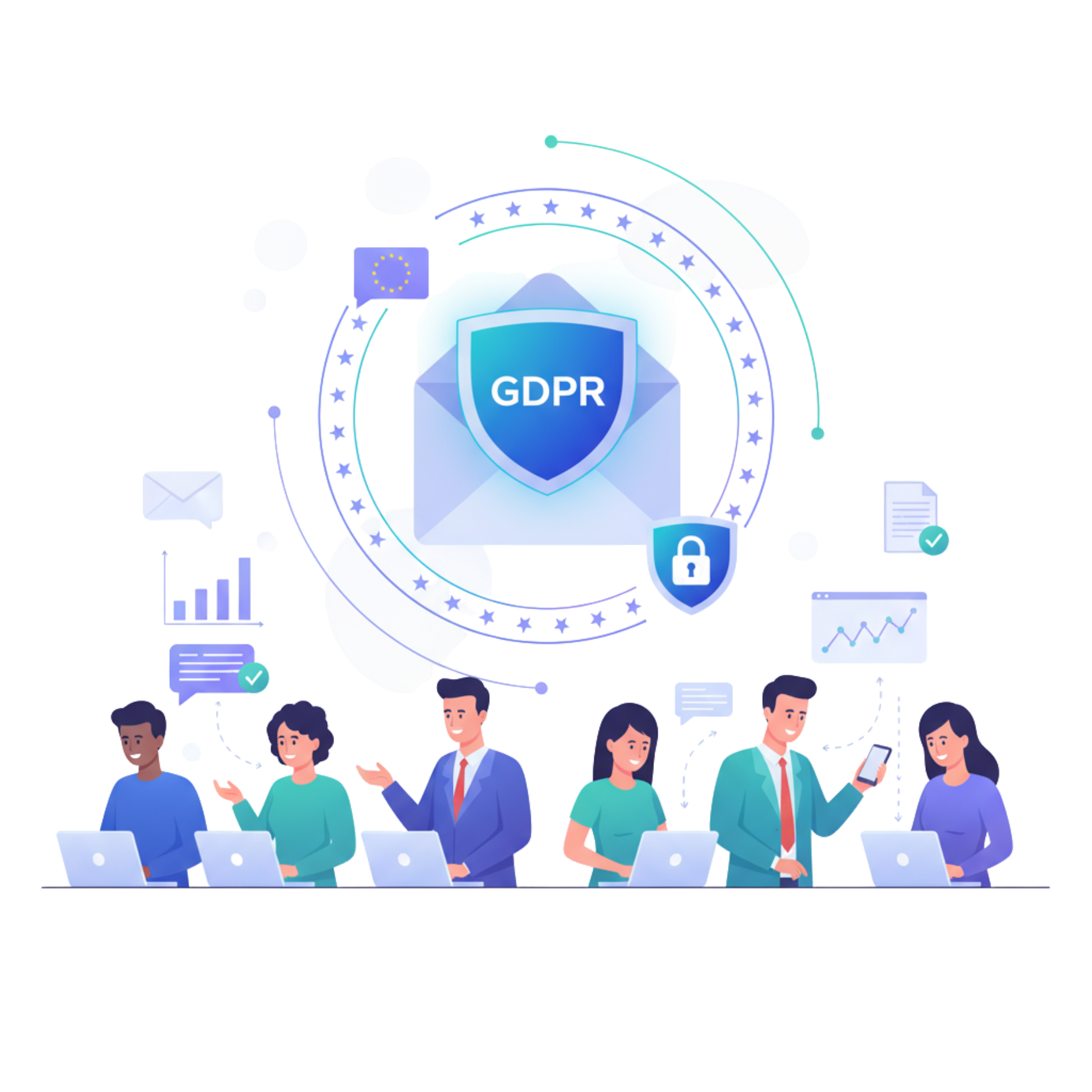The Complete Guide GDPR-Compliant Customer Communication in 2025
Seven years after GDPR implementation, data privacy isn't just a regulatory checkbox—it's a competitive differentiator that directly impacts customer trust and business success. Customers increasingly choose businesses they trust with their personal information, while regulators continue to impose hefty fines on companies that mishandle data privacy requirements.
The stakes have never been higher for businesses operating in today's digital communication landscape. Recent GDPR fines exceeded €1.6 billion in 2024, with communication and marketing violations representing the largest category of penalties.

The High Stakes of GDPR Compliance
GDPR fines in 2024
of customers say data privacy is a growing concern
are willing to pay more for privacy-compliant companies
GDPR compliance isn't just about avoiding fines—it's about building the trust necessary for sustainable business growth.
Understanding GDPR in the Context of Customer Communication
GDPR defines personal data broadly, and customer communication generates vast amounts of information that falls under regulatory protection. Understanding exactly what constitutes personal data in your communication ecosystem is the first step toward effective compliance.
Direct Identifiers
- Phone numbers
- WhatsApp IDs
- Email addresses
- Social media handles
- Names and account numbers
- Voice recordings
Behavioral Data
- Communication preferences and timing
- Channel usage and response rates
- Location data from mobile communications
- Conversation history and sentiment analysis
AI and Analytics Data
- AI-generated customer insights
- Predictive analytics and segmentation
- Automated decision-making results
- Cross-channel interaction patterns
Technical Data
- IP addresses from web chat sessions
- Device fingerprints from mobile messaging
- Metadata from voice calls
- Integration data from CRM systems
Key GDPR Principles for Communication Systems
Legal Basis
Every customer communication must have a valid legal basis under GDPR, with different justifications for different interaction types.
Purpose Limitation
Personal data can only be used for the specific purposes communicated to the individual at the time of collection.
Data Minimization
Collect and process only what's necessary for the stated purpose, avoiding unnecessary data accumulation.
Channel-Specific GDPR Requirements and Implementation
SMS Communications
Requirements:
- Explicit opt-in consent
- Easy opt-out mechanisms
- Detailed consent records
- Encryption during transmission and storage
Example Opt-in:
WhatsApp Business
Requirements:
- Understand Meta's data processing agreements
- Business verification for transparency
- Consent management for marketing messages
- Cross-border data transfer safeguards
Voice Communications
Requirements:
- Prior notice and explicit consent for recording
- Ability to withdraw consent during calls
- Clear purpose limitation for AI processing
Example Disclaimer:
Email Communications
Requirements:
- Double opt-in processes
- Clear explanation of email frequency and content
- Easy unsubscribe mechanisms
- Disclosure of tracking pixels and analytics
Cross-Channel Consent Management Strategies
Unified Consent Framework
- Granular consent collection for each channel and purpose
- Centralized management with channel-specific preferences
- Customer self-service consent preferences
- Complete audit trails for all consent changes
- Automated compliance enforcement across all systems
Teleforce Consent Management
- Real-time consent enforcement across all channels
- Automated compliance reporting
- API integration with external systems
- Complete audit trails for regulatory requirements
- Unified customer preference management
Data Subject Rights Implementation Across Communication Channels
Right to Information
Privacy notices must include:
- Identity and contact details of data controller
- Purposes and legal basis for processing
- Recipients or categories of recipients
- Data retention periods
- Rights available to data subjects
Right of Access (SARs)
Customers can request:
- All personal data held about them
- Purposes of processing
- Recipients of their data
- Retention periods
- Details of automated decision-making
Technical Safeguards and Security Measures
Encryption Requirements
- TLS 1.3 for all data in transit
- AES-256 encryption for data at rest
- Encrypted database connections
- Encrypted backups with secure key management
Access Controls
- Role-based access control for all systems
- Multi-factor authentication for administrative access
- Regular access reviews and deprovisioning
- Comprehensive logging and monitoring
Teleforce Security Features
- Enterprise-grade encryption across all channels
- SOC 2 Type II compliance
- Regular penetration testing and security audits
- Incident response procedures
- Data loss prevention controls
Automated Decision-Making and AI Compliance in Communication
GDPR Requirements for AI
- Right to human intervention for significant decisions
- Regular testing for bias and discrimination
- Explainable AI algorithms where possible
- Clear disclosure of automated processing
- Easy opt-out mechanisms for automated decisions
Communication AI Applications
- Lead scoring and prioritization systems
- Sentiment analysis and escalation triggers
- Chatbot conversations and routing decisions
- Personalized content and offer generation
Building a Comprehensive Compliance Program
Data Mapping & Assessment
Inventory all customer communication channels, map data flows, identify legal basis, and document retention periods.
Risk Assessment
Identify high-risk processing activities, evaluate breach impact, and develop incident response procedures.
Policy Development
Create data protection policies, consent management procedures, and retention/deletion policies.
Staff Training
Provide GDPR principles training, channel-specific compliance training, and regular compliance audits.
Conclusion: Privacy as a Competitive Advantage
GDPR compliance in customer communication has evolved from a regulatory burden to a competitive advantage that builds customer trust and drives business growth. Customers increasingly choose businesses that demonstrate genuine commitment to privacy protection, while avoiding those that treat compliance as a minimal obligation.
The businesses that excel in this environment understand that privacy compliance and effective communication aren't opposing forces—they're complementary strategies that strengthen customer relationships. When customers trust that their personal information is protected and used appropriately, they're more willing to engage across multiple channels, share information that improves service delivery, and maintain long-term business relationships.
The future belongs to businesses that can combine powerful communication capabilities with uncompromising privacy protection. Your customers expect both excellent service and complete privacy protection—and with the right platform and approach, you can deliver both while building stronger, more profitable customer relationships.